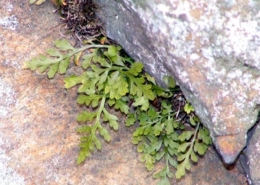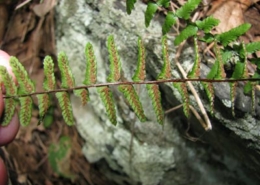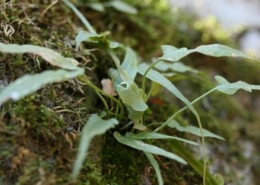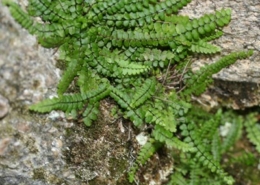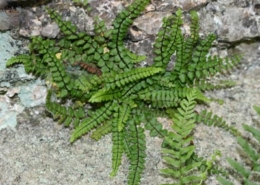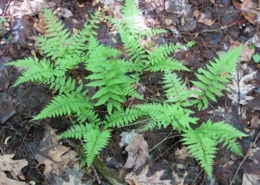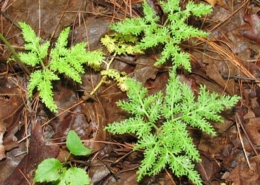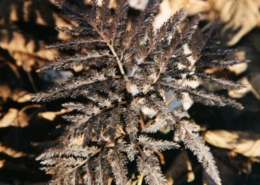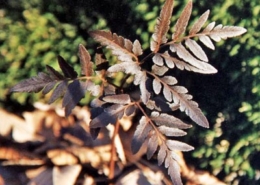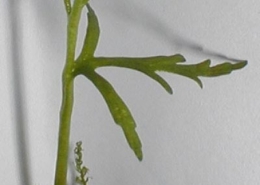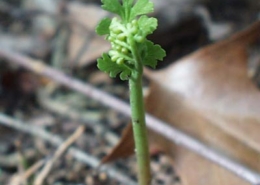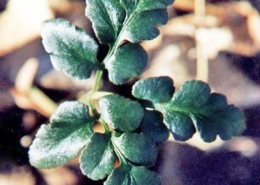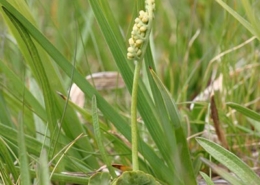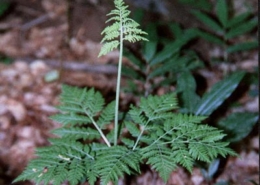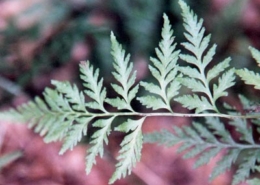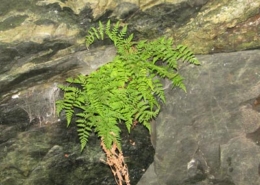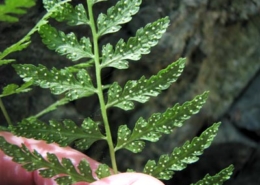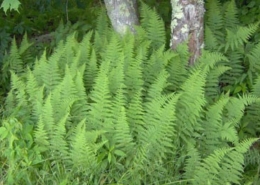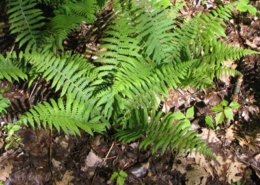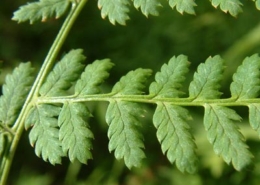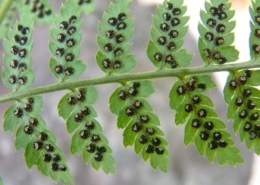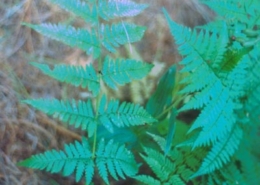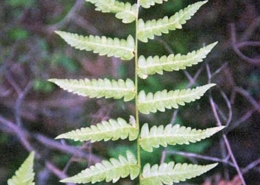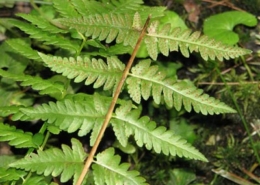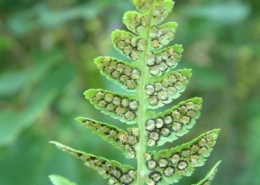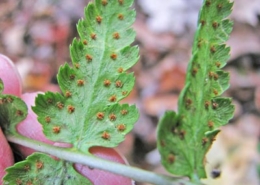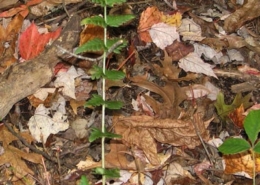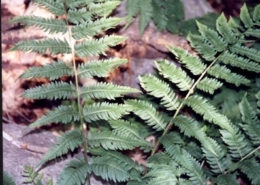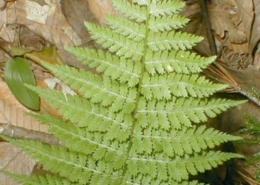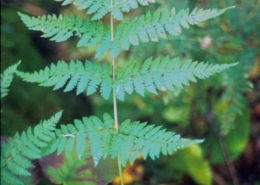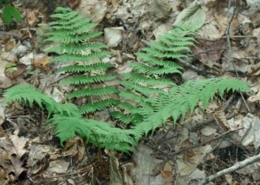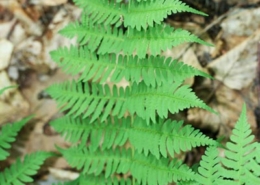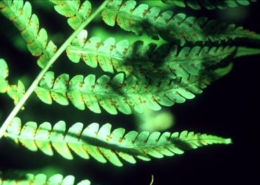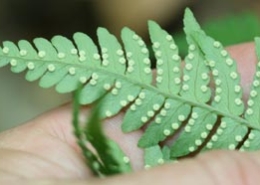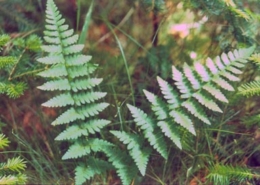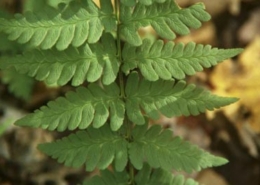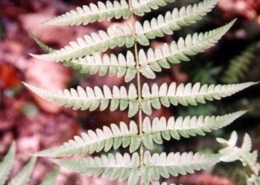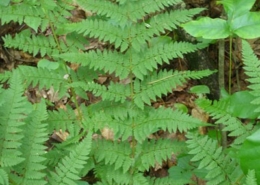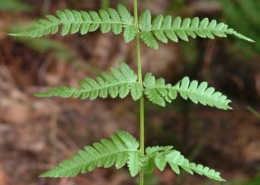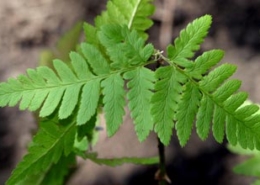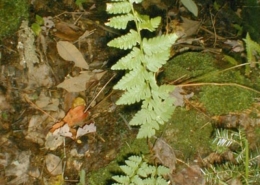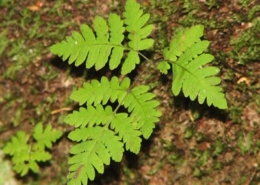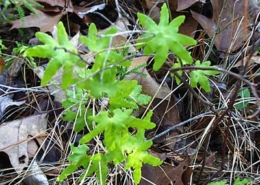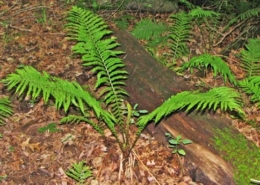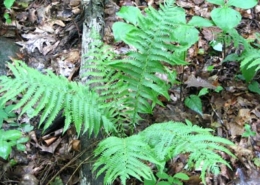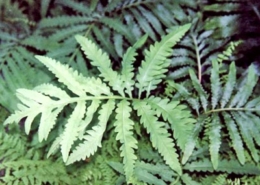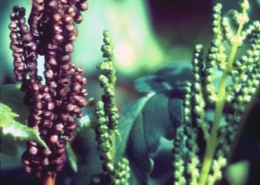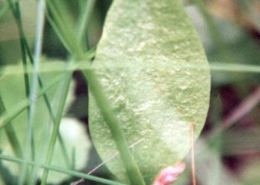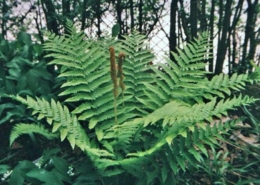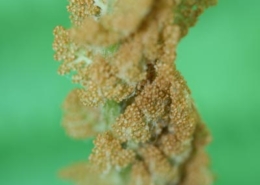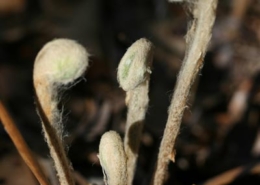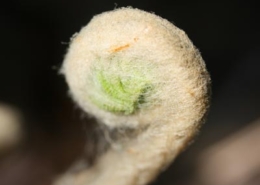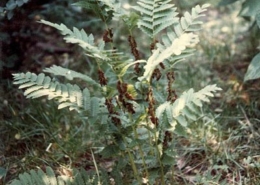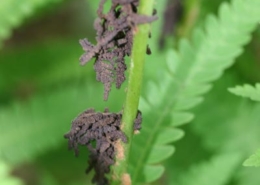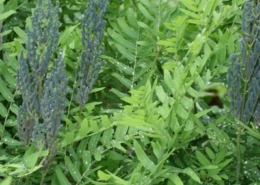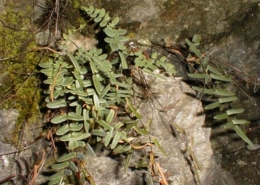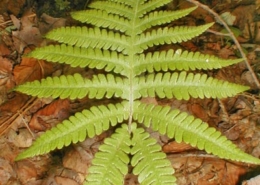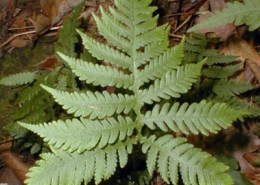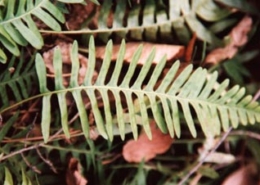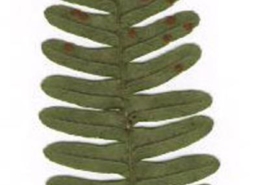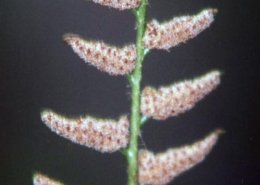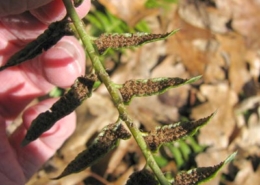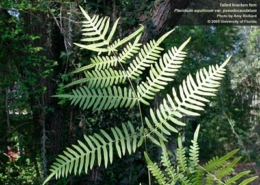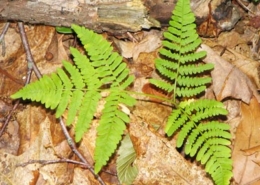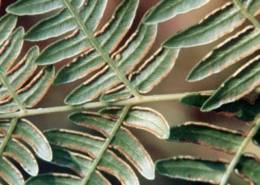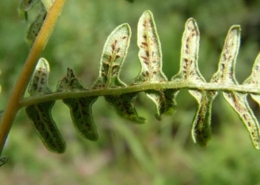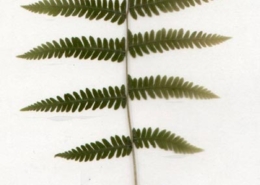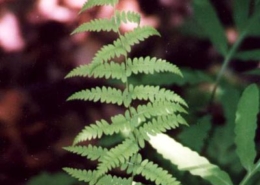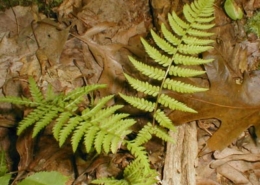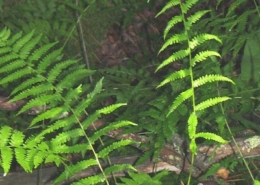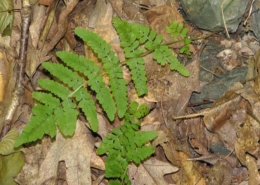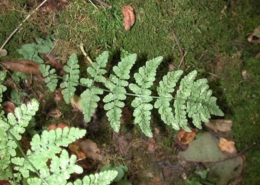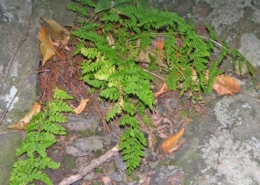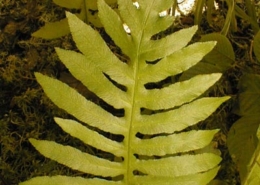Rhode Island Ferns
Francis Underwood, Don Lubin, Kelly Barton – 2011
William W. Bailey, a 19th century Brown University botanist, described Rhode Island ferns as bewitching plants of very various habitats waving their broad plumes in the swamps or nestling under walls. He wrote of the rigid and glossy, evergreen Christmas Fern and the Maidenhair Fern with its polished ebony stems and light graceful sprays. Bailey listed forty species of ferns growing in Rhode Island. Our list is comprised of forty-six species plus six hybrids. Most of these hybrids are produced within the genus Dryopteris, Wood Ferns. Unlike flowering plants, ferns grow from spores, not seeds. Spores may be produced on the undersides of fronds or on separate stalks. When mature, the spores fall to the ground and germinate to produce the gametophyte generation in the life cycle of the fern. The gametophyte, also called prothallus, contains the structures which produce the sperm and the egg. Fertilization of the egg by the sperm results in the production of a sporophyte. This is the generation in the life cycle of the fern which we know as the “adult fern”.
Our ferns range in size from the tiny Least Moonwort (Botrychium simplex) which may be as small as one and one-half inches tall to Cinnamon Fern (Osmunda cinnamomea) which can grow up to six feet tall.
Ferns grow in various habitats ranging from woods or swamps to fields and cliffs. Some grow on limestone cliffs, others on granite cliffs. One of our native ferns can climb to the height of twenty feet. One species, a cliff dweller, has evolved the ability to walk down moss-covered rocks by producing new plants at the tips of its fronds. Habitat information for each species is contained in the pages that follow. In addition, the counties in which the ferns grow and the state status are included.
Francis Underwood
Special Thanks
Don Lubin for helping us with this project and allowing us to use his photos.
The information on Rhode Island Ferns comes from several sources. The dates for mature spores are based on Seymour’s “Flora of New England”. The county and status information is from Rick Enser’s Rare Plants of RI and, for ferns not on the Rare Plant List, the status is taken from Gil George’s Rhode Island Botanical Survey Check List, published in 1999. Francis Underwood provided habitat information and Don Lubin made sure the nomenclature was up-to-date and has added the identification notes.
For a key to the status codes, click here.
To download a PDF (5.8MB) of RI Carnivorous plants click here.
Botanical Name: Adiantum pedatum
Common Name: Maidenhair Fern
Habitat: Rich woods
Blooming Date: July to September
State Status: U
Sites in State: –
Counties found in: Providence,Kent, Washington
Notes from Don Lubin: Unique, delicate frond shape. Dark wiry stems were used to make baskets.
Botanical Name: Asplenium montanum
Common Name: Mountain Spleenwort
Habitat: Non-calcareous rocks
Blooming Date: 5/25 — 8/18
State Status: SE
Sites in State: 1
Counties found in: Providence
Notes from Don Lubin: Small fern, rare in New England.
Botanical Name: Asplenium platyneuron
Common Name: Ebony Spleenwort
Habitat: Thin soils of rocky slopes
Blooming Date: 7/17 — 10/29
State Status: A
Sites in State: –
Counties found in: All
Notes from Don Lubin: Dark stipe and rachis, pinnae eared like Christmas fern.
Botanical Name: Asplenium rhizophyllum
Common Name: Walking Fern
Habitat: Shaded high pH rocks
Blooming Date: 5/13 — 10/1
State Status: SE
Sites in State: 1
Counties found in: Providence
Notes from Don Lubin: Grows flat on rock surface. New plants grow from frond tips.
Botanical Name: Asplenium trichomanes
Common Name: Maidenhair Spleenwort
Habitat: Rock crevices and shaded ledges
Blooming Date: 6/13 — 8/20
State Status: SC
Sites in State: 9
Counties found in: Providence; Kent; Washington
Notes from Don Lubin: Lovely little fern with dark stipe and rachis. Pinnae not eared.
Botanical Name: Athyrium filix-femina (L.) Roth ex Mert.
Common Name: Lady Fern
Habitat: Moist to wet woodlands
Blooming Date: 7/14 — 9/8
State Status: C
Sites in State: –
Counties found in: All
Notes from Don Lubin: Propagates readily by spores, grows unbidden in lawns. Curved sori form herringbone pattern.
Botanical Name: Botrychium dissectum
Common Name: Cut-leaf Grape Fern
Habitat: Dry to moist woodlands
Blooming Date: 7/23 — 9/25 (10/2)
State Status: O
Sites in State: –
Counties found in: All
Notes from Don Lubin: Degree of cutting highly variable. Emerges midsummer, changes from green to bronze in late autumn.
Botanical Name: Botrychium lanceolatum
Common Name: Narrow Triangle Grape Fern
Habitat: Mesic woodlands
Blooming Date: (6/14) 6/24 — 8/31 (9/17)
State Status: SC
Sites in State: 2
Counties found in: Providence; Kent, Washington
Notes from Don Lubin: Wide tropophore projects at right angle, sporophore branched.
Botanical Name: Botrychium matricarifolium
Common Name: Daisyleaf Grape Fern
Habitat: Deciduous woodlands and rarely open areas
Blooming Date: (6/13) 6/24 — 8/20
State Status: SC
Sites in State: 4
Counties found in: Providence; Kent, Washington
Notes from Don Lubin: Narrow tropophore projects at acute angle, sporophore unbranched.
Botanical Name: Botrychium multifidum
Common Name: Leathery Grape Fern
Habitat: Fields or openings in woodlands
Blooming Date: 7/21 — 9/23
State Status: R (Reported found but no sites listed)
Sites in State: ?
Counties found in: ?
Notes from Don Lubin: Stipe particularly stout, pinnules overlap, smaller towards frond tips.
Botanical Name: Botrychium oneidense
Common Name: Blunt-lobed Grape Fern
Habitat: Moist to wet woodlands and swamps
Blooming Date: 7/23 — 9/25 (10/2)
State Status: SH
Sites in State: 0 (1899)
Counties found in: Providence
Notes from Don Lubin: Pinnules rounder than B. dissectum. Does not turn bronze in autumn.
Botanical Name: Botrychium simplex
Common Name: Least Moonwort
Habitat: Moist fields and woodlands
Blooming Date: 6/26 — 8/8
State Status: R
Sites in State: –
Counties found in: Providence, Kent, Washington
Notes from Don Lubin: a moonwort, not a grape fern
Botanical Name: Botrychium tenebrosum
Common Name: Shade-loving Moonwort
Habitat: Shaded woodlands
Blooming Date: 6/26 — 8/8
State Status: R
Sites in State: 1
Counties found in: Kent (?)
Botanical Name: Botrychium virginianum
Common Name: Rattlesnake Fern
Habitat: Rich woodlands
Blooming Date: 6/13 — 8/14
State Status: O
Sites in State: –
Counties found in: Providence, Kent, Washington
Notes from Don Lubin: Largest, most ‘fernlike’ of the Botrychium, with horizontal three-part frond like Bracken. Spore stalk rises from center of frond.
Botanical Name: Cystopteris protrusa
Common Name: Southern Bladder Fern
Habitat: On rich soil of woodlands
Blooming Date: 6/24 — 9/9
State Status: Possibly in RI
Sites in State: –
Counties found in: –
Notes from Don Lubin: Generally grows in soil rather than from rock crevices.
Botanical Name: Cystopteris tenuis
Common Name: Fragile Fern
Habitat: On rocks and sometimes on shaded walls with mortar
Blooming Date: 6/24 — 9/9
State Status: O
Sites in State: –
Counties found in: Providence, Kent, Washington, Newport
Notes from Don Lubin: Delicate ‘airy’ blade. Grows only occasionally in soil, more often on rocks.
Botanical Name: Dennstaedtia punctilobula
Common Name: Hay-scented Fern
Habitat: Ubiquitous in fields, rocks and woodlands
Blooming Date: 7/1 — 9/15
State Status: C
Sites in State: –
Counties found in: All
Notes from Don Lubin: Fronds emerge singly, not in clusters. Note fine white hairs on stipe. Pinnule edges rounded, with no teeth.
Botanical Name: Deparia acrostichoides
Common Name: Silvery Spleenwort or Silvery Glade Fern
Habitat: Rich woodlands
Blooming Date: 7/22 — 9/8 (9/24)
State Status: F
Sites in State: –
Counties found in: Providence, Kent, Washington, Newport
Notes from Don Lubin: Oblong pinnules of equal length. Long white hairs on stipe.
Botanical Name: Dryopteris carthusiana
Common Name: Spinulose Wood Fern
Habitat: Wet or dry woodlands
Blooming Date: 6/27 — 10/11
State Status: C
Sites in State: –
Counties found in: All
Notes from Don Lubin: Turns brown late in fall. Lowest downward pinnule along stipe usually longest.
Botanical Name: Dryopteris clintoniana
Common Name: Clinton’s Wood Fern
Habitat: Moist woodlands
Blooming Date: 7/8 — 9/8
State Status: R
Sites in State: –
Counties found in: Providence
Notes from Don Lubin: Larger than D. cristata, with longer pinnules less blunt. Fertile pinnae twist less.
Notes from Fran Underwood: Clinton’s Wood Fern originated as a naturally occurring hybrid of Crested Wood Fern (D. cristata) and Goldie’s Fern (D. goldiana). Clinton’s differs from Crested in a few characteristics; the pinnae are longer and more narrowly triangular than in Crested. Also, at least in the sterile fronds of Clinton’s, the blades are more abruptly narrowed at the tip, similar to its Goldie’s Fern parent. Both parent ferns have separate fertile and sterile fronds and in both cases, the sterile fronds are evergreen and the fertile fronds are not.
Botanical Name: Dryopteris cristata
Common Name: Crested Wood Fern
Habitat: Swamps and wetlands
Blooming Date: 7/8 — 9/8
State Status: C
Sites in State: –
Counties found in: All
Notes from Don Lubin: Narrow fronds, basal pinnae nearly equilateral triangles. Fertile pinnae twist nearly to horizontal.
Botanical Name: Dryopteris goldiana
Common Name: Goldie’s Wood Fern
Habitat: Rich woodlands
Blooming Date: 7/8 — October
State Status: Possibly in RI
Sites in State: –
Counties found in: –
Notes from Don Lubin: Fronds often tall, with wide pinnae. Frond and pinnae acuminate at apex.
Botanical Name: Dryopteris intermedia
Common Name: Intermediate Wood Fern
Habitat: Woodlands
Blooming Date: 6/25 — 9/12
State Status: C
Sites in State: –
Counties found in: All
Notes from Don Lubin: “Fancy”-cut clustered fern of dry hillsides and rocks. Lowest downward pinnule along stipe generally shorter than adjacent pinnule.
Botanical Name: Dryopteris marginalis
Common Name: Marginal Wood Fern
Habitat: Rocky woods
Blooming Date: 7/8 — 10/13
State Status: C
Sites in State: –
Counties found in: All
Notes from Don Lubin: Evergreen fern likes rocks. Stipes very scaly. Pinnule edges untoothed. Sori at very edge of pinnule.
Botanical Name: Dryopteris X bootii (cristata x intermedia)
Common Name: Boot’s Wood Fern
Habitat: Moist to wet woods
Blooming Date: 7/2 — 10/11
State Status: U
Sites in State: –
Counties found in: Providence, Washington, Bristol
Notes from Don Lubin: Basal pinnae not quite so blunt as D. cristata, more dissected.
Botanical Name: Dryopteris X burgessii (clintoniana x marginalis)
Common Name: Burgess’ Wood Fern
Habitat: Moist to wet woods and swamps
Blooming Date: 7/8 — 10/13
State Status: Possibly in RI
Sites in State: –
Counties found in: –
Botanical Name: Dryopteris x slossonae (cristata x marginalis)
Common Name: Slosson’s Wood Fern
Habitat: Moist to wet rocky woods
Blooming Date: July to October
State Status: R
Sites in State: 2
Counties found in: Providence, Bristol
Notes from Don Lubin: Sori not quite at pinnule margin. Basal pinnae not quite so blunt as D. cristata. Deformations common.
Botanical Name: Dryopteris X triploidea (carthusiana x intermedia)
Common Name: Hybrid Wood Fern
Habitat: Moist to wet woods and swamps
Blooming Date: 6/26 — 10/17
State Status: U
Sites in State: –
Counties found in: Bristol, Providence, Washington, Newport
Notes from Don Lubin: Very common, looks like parents, but often a bit taller.
Botanical Name: Dryopteris X uliginosa (carthusiana x cristata)
Common Name: Marsh Wood Fern
Habitat: Moist to wet woods and swamps
Blooming Date: 6/26 — 10/17
State Status: U
Sites in State: 1
Counties found in: Providence
Botanical Name: Gymnocarpium dryopteris
Common Name: Common Oak Fern
Habitat: Rich woodlands, moss covered wall
Blooming Date: 6/16 — 9/9
State Status: ST
Sites in State: 3
Counties found in: Providence; Kent
Notes from Don Lubin: Three-part frond, like small delicate Bracken.
Botanical Name: Lygodium palmatum
Common Name: Hartford Climbing Fern
Habitat: Moist woodlands in swamps and river flood plains
Blooming Date: 7/22 — 10/3 (11/19)
State Status: SC
Sites in State: 6
Counties found in: Providence; Kent; Washington
Notes from Don Lubin: Palmate pinnae become miniature at fertile tips. Can climb 20 feet. Likes sun.
Botanical Name: Matteuccia struthiopteris
Common Name: Ostrich Fern
Habitat: Rich woods along flood plains also in swamps
Blooming Date: 7/12 — September
State Status: SC
Sites in State: 5
Counties found in: Providence; Kent
Notes from Don Lubin: Very erect vase-shaped clusters. Fronds widest near apex. Pinnules tiny down nearly to ground.
Botanical Name: Onoclea sensibilis
Common Name: Sensitive Fern
Habitat: Marshes, swamps and other wet areas
Blooming Date: 7/15 — 9/1
State Status: C
Sites in State: –
Counties found in: All
Notes from Don Lubin: Coarse rounded fronds not cut entirely to rachis. Sterile fronds short, like beaded stalks with no leaf.
Botanical Name: Ophioglossum pusillum
Common Name: Northern Adder’s-tongue
Habitat: Wet fields, meadows, swamps
Blooming Date: 7/4 — 9/15
State Status: SE
Sites in State: 1
Counties found in: Washington
Notes from Don Lubin: Short, hides in grass. Look for the fertile fronds. Sterile fronds have no midvein.
Botanical Name: Osmunda cinnamomea
Common Name: Cinnamon Fern
Habitat: Moist to wet woods
Blooming Date: 5/23 — 7/14 (8/13)
State Status: C
Sites in State: –
Counties found in: All
Notes from Don Lubin: Dramatic fertile fronds generally have no green leaf. Sterile frond and pinna apex acute.
Botanical Name: Osmunda claytoniana
Common Name: Interrupted Fern
Habitat: Moist to wet woods
Blooming Date: (5/31) 6/6 — 8/24 (9/7)
State Status: C
Sites in State: –
Counties found in: All
Notes from Don Lubin: Frond and pinna apex blunt. Fertile plants easily recognized, if you can find any.
Botanical Name: Osmunda regalis
Common Name: Royal Fern
Habitat: Wet to mesic soils, swamps and occasionally in dry fields
Blooming Date: (5/30) 6/12 — 9/25
State Status: C
Sites in State: –
Counties found in: All
Notes from Don Lubin: Likes wet feet. Oval pinnae, looks more like locust than a fern. Fertile pinnae at frond tips.
Botanical Name: Pellaea atropurpurea
Common Name: Purple Cliffbrake
Habitat: Crevices in limestone
Blooming Date: 6/26 — 10/29
State Status: SE
Sites in State: 1
Counties found in: Providence
Notes from Don Lubin: Stipe dark, pinnae or pinnules oval.
Botanical Name: Phegopteris connectilis
Common Name: Northern Beech Fern
Habitat: Moist woods
Blooming Date: 7/9 — 9/27
State Status: ST
Sites in State: 3
Counties found in: Providence; Kent
Notes from Don Lubin: Arrow-shaped fronds often horizontal. First cutting not complete except between first and second pinnae. Likes stream banks and waterfalls.
Botanical Name: Phegopteris hexagonoptera
Common Name: Broad Beech Fern
Habitat: Moist woods
Blooming Date: 7/24 — 9/24
State Status: R
Sites in State: –
Counties found in: Providence; Kent; Washington
Notes from Don Lubin: Frond shape nearly equilateral triangle. First cutting not complete anywhere. Basal pinnae much more dissected than others.
Botanical Name: Polypodium appalachianum
Common Name: Appalachian Rock Polypody
Habitat: On rocks or thin soil over rocks
Blooming Date: 4/11 — 11/1
State Status: R
Sites in State: 1
Counties found in: Providence
Notes from Don Lubin: Broad triangular evergreen fronds with pointed pinnae.
Botanical Name: Polypodium appalachianum X virginianum (P. X incognitum)
Common Name: Hybrid Polypody
Habitat: On rocks or thin soil over rocks
Blooming Date:
State Status: R
Sites in State: 3
Counties found in: Providence (1941, 2010), Newport (2011)
Notes from Don Lubin: Like parents, perhaps larger, with aborted white spores (Oct. – Nov.)
Botanical Name: Polypodium virginianum
Common Name: Common Rock Polypody
Habitat: On rocks or thin soil over rocks
Blooming Date: 4/11 — 11/1
State Status: C
Sites in State: –
Counties found in: All
Notes from Don Lubin: Narrow bitapering fronds with rounded pinna tips. Thoreau’s “cheerful communities”.
Botanical Name: Polystichum acrostichoides
Common Name: Christmas Fern
Habitat: Rich soil in woodlands and on rocky hillsides
Blooming Date: 7/2 — 9/2
State Status: C
Sites in State: –
Counties found in: All
Notes from Don Lubin: Dark evergreen fern, pinnae with upward “ears” along rachis, fertile pinnae towards tip are smaller.
Botanical Name: Pteridium aquilinum ssp. pseudocaudatum
Common Name: Clute’s Bracken Fern
Habitat: Dry woodlands and fields
Blooming Date: 7/7 — 9/25
State Status: Possibly in RI
Sites in State: –
Counties found in: –
Botanical Name: Pteridium aquilinum v. latiusculum
Common Name: Eastern Bracken Fern
Habitat: Dry woodlands and fields
Blooming Date: 7/7 — 9/25
State Status: C
Sites in State: –
Counties found in: All
Notes from Don Lubin: Horizontal three-part blade. Fronds emerge singly. Stipe deeply grooved. Seldom fertile.
Botanical Name: Thelypteris novoboracensis
Common Name: New York Fern
Habitat: Open woodlands
Blooming Date: 7/26 — 9/22
State Status: C
Sites in State: –
Counties found in: All
Notes from Don Lubin: Bitapering, pinnae nearly to ground, becoming very tiny.
Botanical Name: Thelypteris palustris
Common Name: Marsh Fern
Habitat: Woodlands with moist soil, swamps and marshes
Blooming Date: 8/2 — 10/11
State Status: C
Sites in State: –
Counties found in: All
Notes from Don Lubin: Blade widest near base, long brown stipe. Veins forked in sterile fronds.
Botanical Name: Thelypteris simulata
Common Name: Massachusetts Fern
Habitat: Deciduous woodlands with moist soil
Blooming Date: 8/3 — 9/27 (10/6)
State Status: O
Sites in State: –
Counties found in: All
Notes from Don Lubin: Frond shape intermediate between Marsh and New York ferns, with lower pinnae reduced somewhat. Lower pinnae narrow toward rachis.
Botanical Name: Woodsia ilvensis
Common Name: Rusty Woodsia
Habitat: Rocky slopes, cliffs and ledges
Blooming Date: (6/18) 7/8 — 10/4
State Status: SH
Sites in State: 0 (1977)
Counties found in: Providence
Notes from Don Lubin: Very scaly small fern
Botanical Name: Woodsia obtusa
Common Name: Blunt-lobed Woodsia
Habitat: On rocks in woodlands in sun or shade
Blooming Date: 7/16 — 10/29
State Status: U
Sites in State: –
Counties found in: Providence, Kent, Washington, Newport
Notes from Don Lubin: Stipes quite scaly.
Botanical Name: Woodwardia areolata
Common Name: Netted Chain Fern
Habitat: Swamps and wet woods
Blooming Date: 7/28 — 10/14
State Status: U
Sites in State: –
Counties found in: All
Notes from Don Lubin: Like Sensitive fern, but pinnae edges finely toothed, not scalloped. Tall fertile fronds like sterile, but much narrowed.
Botanical Name: Woodwardia virginica
Common Name: Virginia Chain Fern
Habitat: Marshes and swamps in shade or sun
Blooming Date: 7/22 — 9/19
State Status: O
Sites in State: –
Counties found in: All
Notes from Don Lubin: Fronds grow in distinct lines, not clusters. Stipe and rachis dark, blade twice-cut like Cinnamon fern, but pinnae narrow toward rachis.


